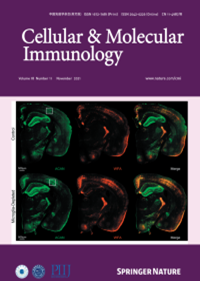The AhR-Ovol1-Id1 regulatory axis in keratinocytes promotes epidermal and immune homeostasis in atopic dermatitis-like skin inflammation
IF 21.8
1区 医学
Q1 IMMUNOLOGY
引用次数: 0
Abstract
The skin is our outer permeability and immune defense barrier against myriad external assaults. Aryl hydrocarbon receptor (AhR) senses environmental factors and regulates barrier robustness and immune homeostasis. AhR agonists have been approved by the FDA for psoriasis treatment and are in clinical trials for the treatment of atopic dermatitis (AD), but the underlying mechanism of action remains poorly defined. Here, we report that OVOL1/Ovol1 is a conserved and direct transcriptional target of AhR in epidermal keratinocytes. We show that OVOL1/Ovol1 influences AhR-mediated regulation of keratinocyte gene expression and that OVOL1/Ovol1 ablation in keratinocytes impairs the barrier-promoting function of AhR, exacerbating AD-like inflammation. Mechanistically, we have identified Ovol1’s direct downstream targets genome-wide and provided in vivo evidence supporting the role of Id1 as a functional target in barrier maintenance, disease suppression, and neutrophil accumulation. Furthermore, our findings reveal that an IL-1/dermal γδT cell axis exacerbates type 2 and 3 immune responses downstream of barrier perturbation in Ovol1-deficient AD skin. Finally, we present data suggesting the clinical relevance of OVOL1 and ID1 functions in human AD skin. Our study highlights a keratinocyte-intrinsic AhR-Ovol1-Id1 regulatory axis that promotes both epidermal and immune homeostasis in the context of skin inflammation, identifying new therapeutic targets.

角化细胞中的AhR-Ovol1-Id1调节轴促进特应性皮炎样皮肤炎症的表皮和免疫稳态。
皮肤是我们的外部渗透性和免疫防御屏障,抵御无数的外部攻击。芳烃受体(Aryl hydrocarbon receptor, AhR)是一种感知环境因素并调节屏障稳健性和免疫稳态的受体。AhR激动剂已被FDA批准用于治疗牛皮癣,并正在进行治疗特应性皮炎(AD)的临床试验,但其潜在的作用机制仍不明确。在这里,我们报道了OVOL1/ OVOL1是表皮角质形成细胞中AhR的一个保守的直接转录靶点。我们发现OVOL1/ OVOL1影响AhR介导的角化细胞基因表达的调节,并且OVOL1/ OVOL1在角化细胞中的消融会损害AhR的屏障促进功能,加剧ad样炎症。在机制上,我们已经确定了Ovol1在全基因组范围内的直接下游靶点,并提供了体内证据支持Id1在屏障维持、疾病抑制和中性粒细胞积累中作为功能靶点的作用。此外,我们的研究结果表明,IL-1/真皮γδT细胞轴加剧了ovol1缺陷AD皮肤屏障扰动下游的2型和3型免疫反应。最后,我们提供的数据表明OVOL1和ID1功能在人类AD皮肤中的临床相关性。我们的研究强调了角化细胞固有的AhR-Ovol1-Id1调节轴,在皮肤炎症的背景下促进表皮和免疫稳态,确定了新的治疗靶点。
本文章由计算机程序翻译,如有差异,请以英文原文为准。
求助全文
约1分钟内获得全文
求助全文
来源期刊
CiteScore
31.20
自引率
1.20%
发文量
903
审稿时长
1 months
期刊介绍:
Cellular & Molecular Immunology, a monthly journal from the Chinese Society of Immunology and the University of Science and Technology of China, serves as a comprehensive platform covering both basic immunology research and clinical applications. The journal publishes a variety of article types, including Articles, Review Articles, Mini Reviews, and Short Communications, focusing on diverse aspects of cellular and molecular immunology.

 求助内容:
求助内容: 应助结果提醒方式:
应助结果提醒方式:


